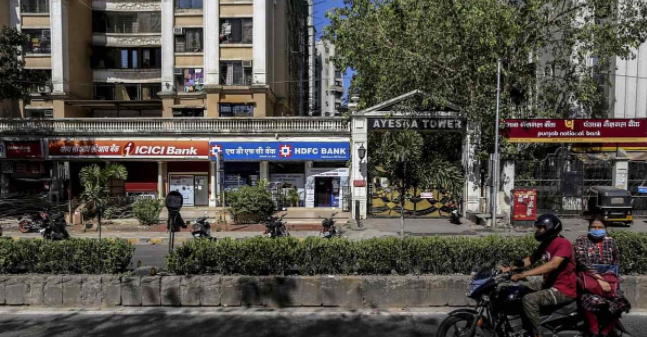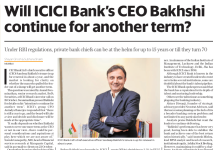Ira Dugal @dugalira Apr 27 2021, 7:46 AM IST Apr 28 2021, 4:20 PM IST
When seen over cycles, it can be said that every bank has its year.
In the early 2000s and until a little after the global financial crisis, it was ICICI Bank Ltd. that was grabbing the growth. Then came the downturn, an asset quality review and governance issues. The lender fell out of the favourites list and from first to second place in the pecking order of private banks by assets.
It was then HDFC Bank Ltd.’s turn to shine. Its caution, once seen as growth-impairing, was celebrated, it grew when others were cleaning-up, and became the undisputed leader. Then came a few governance issues, a management transition, technology troubles and now a retreat into its customary caution amid a new crisis.
Lo and behold, views have come full cycle and ICICI Bank is back in the spotlight. In the stock markets at least.
The Pandemic Year
The pandemic year saw the two largest private lenders take divergent paths. That is visible from the growth in the two loan books and, in particular, where the upside came from.
- ICICI Bank saw its domestic loan book grow 18% in the pandemic year. HDFC Bank grew slightly slower at 14%. Both outperformed the system, which saw loan growth of 6%.
- The real surprise is in the growth across segments. Retail loans for ICICI Bank grew 20% over the year, while retail powerhouse HDFC Bank grew that book just 6.7%.
- For HDFC Bank, wholesale loans rose 21.7%, while ICICI reported that corporate loans grew 13.2% over the year. Note here that for HDFC Bank, wholesale loans include small business loans, while ICICI reports those separately. However, the share of those loans is small.
The result is that ICICI Bank, the original project financier and corporate-focused lender, now has 67% of its loan book in retail assets. In contrast, retail powerhouse HDFC Bank’s loan book is slightly more weighted towards wholesale loans, which make up 53% of the book.
As long-time banking sector watcher Suresh Ganapathy of Macquarie asked in a note on Apr. 26, “When was the last time that you saw ICICI Bank growing faster than HDFC Bank?” It was 15 years ago in the FY06-07 period,” he answered. “We all knew how that ended…,” wrote Ganapathy but added that this time ICICI appears to be growing better.
Within the broader categories, where is ICICI’s growth coming from?
Mortgages, which form 50% of the retail book, grew 22%, Macquarie Research said. In the corporate loans category, the share of A- and above rated corporates has gone up from 56% in FY17 to ~73% in FY21. “So, they have focused more on safer assets and grown the balance sheet,” Ganapathy said.
But there is always a reason to track rapid growth with some degree of caution, particularly in banking. Hemindra Hazari, another veteran banking analyst, wrote on his website that investors need to monitor the bank’s focus on mortgages.
“Within mortgages, the loan against property portfolio needs to be carefully monitored, as such loans can result in higher losses when there is a downturn. Although mortgages are secured, the asset value can plummet when lenders sell the security to realise the loan,” Hazari wrote, adding that “it is interesting to observe that, while HDFC Bank is de-emphasising retail loans, ICICI Bank still continues to aggressively grow retail.”
Still Some Distance Away From #1
To be sure, while ICICI Bank may have grown a touch faster this year, the gap between the balance sheets of the two lenders has widened over the years. As such HDFC Bank remains in the lead. Remember, it was only in FY16 that HDFC Bank became the largest lender in terms of balance sheet size but it has strengthened its lead since then while ICICI continued to clean-up.
There are many other aspects where HDFC Bank is well ahead of its nearest competitor.
- ICICI Bank’s net interest margin for FY21 settled at 3.84%, while HDFC Bank’s remains much higher at 4.2%
- Return on assets for ICICI Bank is at 0.9% for FY21, while for its larger competitor it is at 1.5%, based on Macquarie estimates. Return on equity for the former is at 8.5% versus 13.5% for the latter.
- Finally, while ICICI Bank has brought down its gross non performing assets to 5.3% and net NPAs to 1.2%; remember that it took almost half a decade of cleaning-up to get here. HDFC Bank remains the steady workhorse in this regard with gross NPA at 1.4% and net NPA at 0.4% and little volatility to speak of in asset quality.

Growth Over Consistency?
But markets want growth right now and analysts appear to be leaning slightly in favour of ICICI Bank to lead that growth. That’s not to say that HDFC Bank’s believers have deserted it.
100% of analysts covering ICICI Bank have a ‘Buy’ call on it, while for HDFC Bank that share is 92%, with a few ‘holds’ and ‘sells’ thrown it. The consensus 12-month target price of Rs 1,756 per share reflects a 25% return for HDFC Bank. For ICICI, the return potential over a 12-month period is 21% based on the consensus target price of Rs 715 per share.
Over the past 12 months though, the ICICI stock has outperformed, rising 70% from the pandemic lows compared to a 51% rise in HDFC Bank shares.

HDFC Bank has “delivered very strong asset quality during the first wave but growth outcomes in the near term will need to be watched given corporate deleveraging and slower unsecured growth,” said CLSA in a report post the bank’s earnings last week.
The same brokerage, in response to ICICI Bank’s earnings, said the lender could potentially be a growth leader in the next cycle. “With an end to the past 5-6 year intense corporate credit cycle, its improving granularity of earnings and potentially ICICI Bank being the new growth leader among large banks, we expect the rerating to continue.”
Jefferies chose to focus on the reducing volatility in ICICI Bank earnings, which it believes is enough reason for the lender to close the valuation gap with its larger peer. HDFC Bank trades at a price-to-book ratio of 3.80 times, according to the BSE. ICICI trades at 2.77 times.
“An improvement in velocity of ICICI’s operating profit growth and steady credit cost will bring down volatility in earnings, which has been a key reason for 55% discount in valuation vs. HDFC Bank,” Jefferies said.














